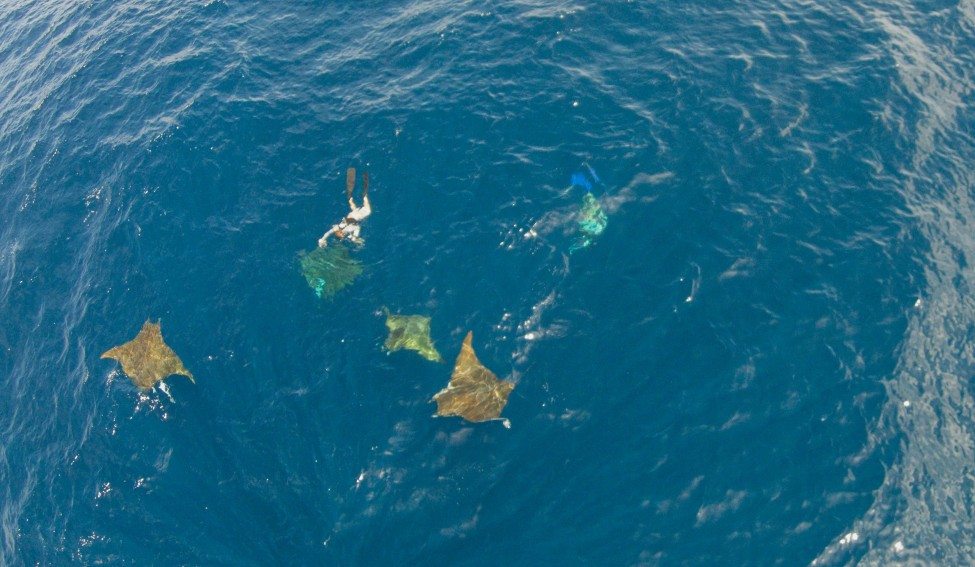Devil ray paradise in the mid-Atlantic
A small group of rocky islets in the middle of the ocean seems an unlikely location for human habitation, but when those humans are marine scientists the logic becomes clearer – and even more so when, as Ramón Bonfil describes, the islets are a seasonal home to little-known devil rays.
Photo by Ramon Bonfil
A few hours after darkness recedes and morning light fills the entire sky, we begin to distinguish the low silhouette of the rocky outcrop on the horizon just in front of us. It has been a long and tedious voyage from the Brazilian island of Fernando de Noronha: two days and two nights in a 20-metre (65-foot) fishing boat, with not much to do but look at the sea and sky for endless hours or lie in our tiny bunk beds to avoid seasickness and keep some food in our stomachs. But now, finally, we are closing in on our destination and excitement replaces boredom. Soon we will arrive at one of the most remote and inhospitable marine paradises on earth, a place of rough beauty where a few rocks are surrounded by deep blue seas full of marine life.
We are heading to the Archipelago of Saint Peter and Saint Paul, known in shorthand as the ASPSP. These distant islets lie in the middle of the Atlantic Ocean between Brazil and Africa, nearly 1,100 kilometres (700 miles) from Natal at the eastern corner of Brazil and 800 kilometres (500 miles) from Fernando de Noronha. Spearing out of the sea surface from depths of 4,000 metres (13,000 feet), they are one of the few outcrops of the submarine mountain chain of the mid-Atlantic Ridge, a place where the sea floor is continually spreading as the earth’s crust gives way to new material from the planet’s core. There are only nine places in the Atlantic Ocean where this mountain chain emerges from the sea to form landmasses with enough area to offer refuge for marine birds and sailors. But what makes the ASPSP unique is the fact that, of all the mid-Atlantic outcrops, it is closest to the equator and by far the smallest. The archipelago comprises just four small and six larger islets, as well as various rock points, and the longest distance between two points is just 420 metres (460 yards). In addition, it sits in an enviable location, between the northern and southern hemispheres and halfway between the American and African continents.
Discovered by Portuguese sailors in the early 16th century, the ASPSP was often used as a place where humans could find food (brown boobies and their eggs, fish, sea turtles) on the voyage between South America and Europe. However, it also represented a threat to sailors. Due to their low altitude (the highest point is a mere 18 metres, or 60 feet, above sea level) and small size, the rocky outcrops were difficult to locate before a lighthouse was installed, as several shipwrecks around the archipelago attest. The first of these, and probably the one that marked the discovery of the ASPSP, was the shipwreck of the Portuguese vessel São Pedro, which struck the rocks and sank here in 1511 on its way to Mozambique. Another ship in the same fleet, the São Paulo, rescued the survivors. (Ever wondered where the archipelago’s name comes from?)
The first recorded landing on the ASPSP was by the Frenchman Bouvet du Losier in 1738. Several other explorers followed, including notable visitors such as Charles Darwin, who landed here in February 1832 during the HMS Beagle expedition, and Ernest Shackleton in 1921 aboard Quest. Numerous scientific and trade voyages set foot here, including the HMS Challenger marine research expedition in the 1870s, but the place remained of little interest to colonising nations and maritime empires due to its perceived poor value when compared to other treasured prizes that could be claimed and exploited. Brazil’s possession of the archipelago was a de facto inheritance when it gained independence from Portugal. The islets remained largely in oblivion for a very long time, until the first lighthouse was erected in the 1930s. Later, in 1960, they had a claim to fame as the starting and end point for the first submerged circumnavigation of the world, made by the nuclear submarine USS Triton.
This tiny place is a jewel of marine life. Although the only permanent inhabitants of the dry rocks are brown boobies, noddies of two species and red rock crabs (and four human researchers at a time!), the waters around them hold several species of algae, invertebrates, cartilaginous and bony fishes, and marine mammals and reptiles. The known diversity of species is modest, due partly to the small size of the archipelago and partly to the difficulty of exploring its deep-water fauna, but the abundance and beauty of some species is great. The current biodiversity list runs to at least 107 phytoplanktonic and 205 zooplanktonic taxa, 32 sponges, 81 taxa of molluscs and 123 fish species. Common inhabitants of and visitors to the ASPSP are yellowfin and bigeye tuna, white and blue marlins, several species of jacks, flying fish, silky, Galapagos, dusky and whale sharks, giant manta rays and two species of devil rays. In addition, there are plenty of green and hawksbill turtles, and the always-thrilling bottlenose dolphins.
Latin America’s devil rays
Devil rays, or mobula rays as they are also known, travel vast distances. Ramón is using satellite tags to get the inside scoop on their lifestyle, because by knowing when and where they travel, we will have a better chance of protecting them.

